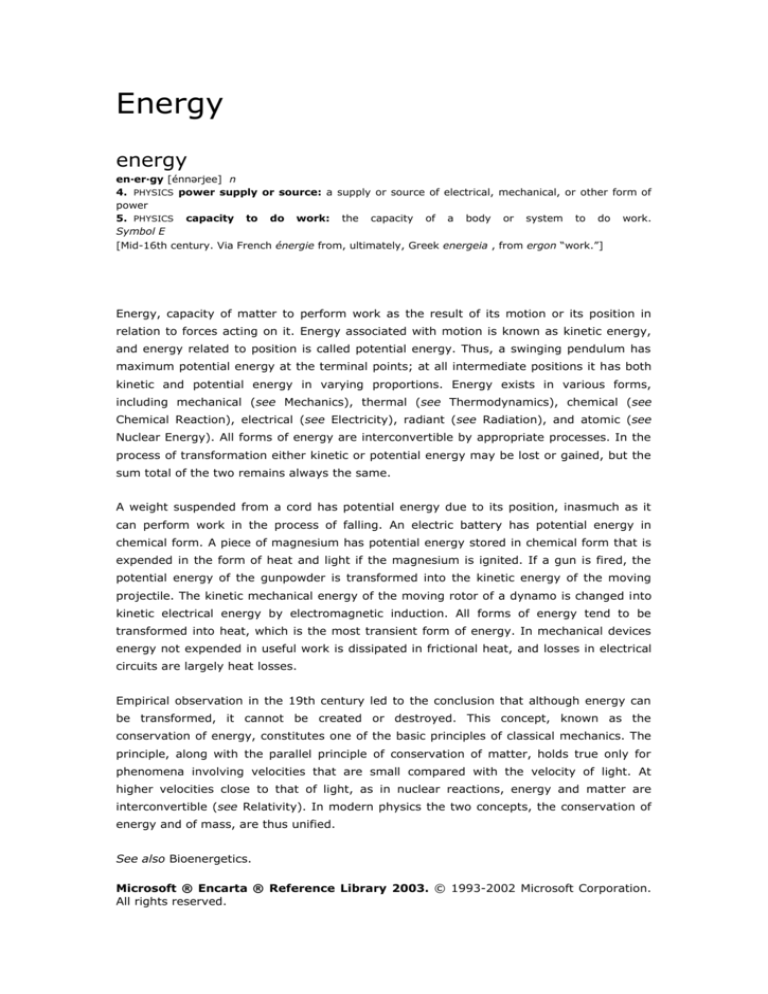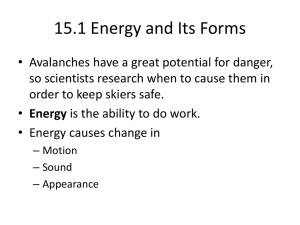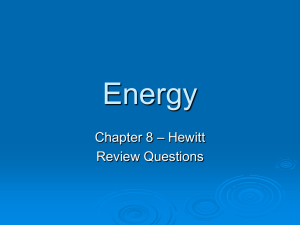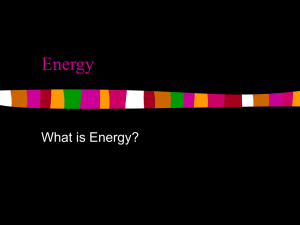
Energy
energy
en·er·gy [énnərjee] n
4. PHYSICS power supply or source: a supply or source of electrical, mechanical, or other form of
power
5. PHYSICS capacity to do work: the capacity of a body or system to do work.
Symbol E
[Mid-16th century. Via French énergie from, ultimately, Greek energeia , from ergon “work.”]
Energy, capacity of matter to perform work as the result of its motion or its position in
relation to forces acting on it. Energy associated with motion is known as kinetic energy,
and energy related to position is called potential energy. Thus, a swinging pendulum has
maximum potential energy at the terminal points; at all intermediate positions it has both
kinetic and potential energy in varying proportions. Energy exists in various forms,
including mechanical (see Mechanics), thermal (see Thermodynamics), chemical (see
Chemical Reaction), electrical (see Electricity), radiant (see Radiation), and atomic (see
Nuclear Energy). All forms of energy are interconvertible by appropriate processes. In the
process of transformation either kinetic or potential energy may be lost or gained, but the
sum total of the two remains always the same.
A weight suspended from a cord has potential energy due to its position, inasmuch as it
can perform work in the process of falling. An electric battery has potential energy in
chemical form. A piece of magnesium has potential energy stored in chemical form that is
expended in the form of heat and light if the magnesium is ignited. If a gun is fired, the
potential energy of the gunpowder is transformed into the kinetic energy of the moving
projectile. The kinetic mechanical energy of the moving rotor of a dynamo is changed into
kinetic electrical energy by electromagnetic induction. All forms of energy tend to be
transformed into heat, which is the most transient form of energy. In mechanical devices
energy not expended in useful work is dissipated in frictional heat, and losses in electrical
circuits are largely heat losses.
Empirical observation in the 19th century led to the conclusion that although energy can
be transformed, it cannot be created or destroyed. This concept, known as the
conservation of energy, constitutes one of the basic principles of classical mechanics. The
principle, along with the parallel principle of conservation of matter, holds true only for
phenomena involving velocities that are small compared with the velocity of light. At
higher velocities close to that of light, as in nuclear reactions, energy and matter are
interconvertible (see Relativity). In modern physics the two concepts, the conservation of
energy and of mass, are thus unified.
See also Bioenergetics.
Microsoft ® Encarta ® Reference Library 2003. © 1993-2002 Microsoft Corporation.
All rights reserved.
Einstein's mass–energy relation
relationship between mass (m) and energy (E) in the special theory of relativity
of Albert Einstein, embodied by the formula E = mc2, where c equals 300,000
kilometres (186,000 miles) per second—i.e., the speed of light.
In physical theories prior to that of special relativity, mass and energy were
viewed as distinct entities. Furthermore, the energy of a body at rest could be
assigned an arbitrary value. In special relativity, however, the energy of a body
at rest is determined to be mc2. Thus, each body of mass m possesses mc2 of
“rest energy,” which potentially is available for conversion to other forms of
energy. The mass–energy relation, moreover, implies that if energy is released
from the body as a result of such a conversion, then the mass of the body will
decrease. Such a conversion of rest energy to other forms of energy occurs in
ordinary chemical reactions, but much larger conversions occur in nuclear
reactions. This is particulary true in the case of nuclear-fusion reactions that
transform hydrogen to helium, in which 0.7 percent of the originalrest energy of
the hydrogen is converted to other forms of energy.
Energy (Britannica)
in physics, the capacity for doing work. It may exist in potential, kinetic, thermal,
electrical, chemical, nuclear, or other various forms. There are, moreover, heat and work-i.e., energy in the process of transfer from one body to another. After it has been
transferred, energy is always designated according to its nature. Hence, heat transferred
may become thermal energy, while work done may manifest itself in the form of
mechanical energy.
All forms of energy are associated with motion. For example, any given body has kinetic
energy if it is in motion. A tensioned device such as a bow or spring, though at rest, has
the potential for creating motion; it contains potential energy because of its configuration.
Similarly, nuclear energy is potential energy because it results from the configuration of
subatomic particles in the nucleus of an atom.
Energy can be converted from one form to another in various ways. Usable mechanical or
electrical energy is, for instance, produced by many kinds of devices, including fuelburning heat engines, generators, batteries, fuel cells, and magnetohydrodynamic
systems.
Energy is treated in a number of articles. For the development of the concept of energy
and the principle of energy conservation, see Physical Science, Principles of; Mechanics;
Thermodynamics, Principles of. For the major sources of energy and the mechanisms by
which the transition of energy from one form to another occurs, see Atoms: Energy from
atoms; Fuels, Fossil; Electricity and Magnetism; Energy Conversion.
kinetic energy
form of energy that an object or a particle has by reason of its motion. If work,
which transfers energy, is done on an object by applying a net force, the object
speeds up and thereby gains kinetic energy. Kinetic energy is a property of a
moving object or particle and depends not only on its motion but also on its
mass. The kind of motion may be translation (or motion along a path from one
place to another), rotation about an axis, vibration, or any combination of
motions.
Translational kinetic energy of a body is equal to one-half the product of its mass,
m, and the square of its velocity, v, or 1/2mv2.
This formula is valid only for low to relatively high speeds; for extremely highspeed particles it yields values that are too small. When the speed of an object
approaches that of light (3 × 108 metres per second, or 186,000 miles per
second), its mass increases, and the laws of relativity must be used. Relativistic
kinetic energy is equal to the increase in the mass of a particle over that which it
has at rest multiplied by the square of the speed of light.
The unit of energy in the metre-kilogram-second system is the joule. A twokilogram mass (something weighing 4.4 pounds on Earth) moving at a speed of
one metre per second (slightly more than two miles per hour) has a kinetic
energy of one joule. In the centimetre-gram-second system the unit of energy is
the erg, 10−7 joule, equivalent to the kinetic energy of a mosquito in flight.
Other units of energy also are used, in specific contexts, such as the still smaller
unit, the electron volt, on the atomic and subatomic scale.
For a rotating body, the moment of inertia, I, corresponds to mass, and the
angular velocity (omega), ω, corresponds to linear, or translational, velocity.
Accordingly, rotational kinetic energy is equal to one-half the product of the
moment of inertia and the square of the angular velocity, or 1/2Iω2.
The total kinetic energy of a body or a system is equal to the sum of the kinetic
energies resulting from each type of motion.
potential energy
stored energy that depends upon the relative position of various parts of a
system. A spring has more potential energy when it is compressed or stretched. A
steel ball has more potential energy raised above the ground than it has after
falling to the Earth. In the raised position it is capable of doing more work.
Potential energy is a property of a system and not of an individual body or
particle; the system composed of the Earth and the raised ball, for example, has
more potential energy as the two are farther separated.
Potential energy arises in systems with parts that exert forces on each other of a
magnitude dependent on the configuration, or relative position, of the parts. In
the case of the Earth–ball system, the force of gravity between the two depends
only on the distance separating them. The work done in separating them farther,
or in raising the ball, transfers additional energy to the system, where it is stored
as gravitational potential energy.
Potential energy also includes other forms. The energy stored between the plates
of a charged capacitor is electrical potential energy. What is commonly known as
chemical energy, the capacity of a substance to do work or to evolve heat by
undergoing a change of composition, may be regarded as potential energy
resulting from the mutual forces among its molecules and atoms. Nuclear energy
is also a form of potential energy.
The potential energy of a system of particles depends only on their initial and
final configurations; it is independent of the path the particles travel. In the case
of the steel ball and the earth, if the initial position of the ball is ground level and
the final position is ten feet above the ground, the potential energy is the same,
no matter how or by what route the ball was raised. The value of potential energy
is arbitrary and relative to the choice of reference point. In the case given above,
the system would have twice as much potential energy if the initial position were
the bottom of a ten-foot-deep hole.
Gravitational potential energy near the Earth's surface may be computed by
multiplying the weight of an object by its distance above the reference point. In
bound systems, such as atoms, in which electrons are held by the electric force of
attraction to nuclei, the zero reference for potential energy is a distance from the
nucleus so great that the electric force is not detectable. In this case, bound
electrons have negative potential energy, and those just free of the nucleus and
at rest have zero potential energy.
Potential energy may be converted into energy of motion, called kinetic energy,
and in turn to other forms such as electrical energy. Thus, water behind a dam
flows to lower levels through turbines that turn electric generators, producing
electric energy plus some unusable heat energy resulting from turbulence and
friction.
Historically, potential energy was included with kinetic energy as a form of
mechanical energy so that the total energy in gravitational systems could be
calculated as a constant.
Mass (physics)
mass
mass [mass]
n (plural mass·es)
5. PHYSICS physical quantity: the property of an object that is a measure of its inertia, the amount
of matter it contains, and its influence in a gravitational field.
Symbol m
[14th century. Via French masse and Latin massa from Greek maza “barley cake.”]
Mass (physics), in physics, amount of matter that a body contains, and a measure of the
inertial property of that body, that is, of its resistance to change of motion (see Inertia).
Mass is different from weight, which is a measure of the attraction of the earth for a given
mass (see Gravitation). Inertial mass and gravitational mass are identical. Weight,
although proportional to mass, varies with the position of a given mass relative to the
earth; thus, equal masses at the same location in a gravitational field will have equal
weights. A mass in interstellar space may have nearly zero weight. A fundamental principle
of classical physics is the law of conservation of mass, which states that matter cannot be
created or destroyed. This law holds true in chemical reactions but is modified in cases
where atoms disintegrate and matter is converted to energy or energy is converted to
matter (see Nuclear Energy; X Ray: Pair Production).
The theory of relativity, initially formulated in 1905 by the German-born American
physicist Albert Einstein, did much to change traditional concepts of mass. In modern
physics, the mass of an object is regarded as changing as its velocity approaches that of
light, that is, when it approaches 300,000 km/sec (about 186,000 mi/sec); an object
moving at a speed of approximately 260,000 km/sec (about 160,000 mi/sec), for example,
has a mass about double its so-called rest mass. Where such velocities are involved, as in
nuclear reactions, mass can be converted into energy and vice versa, as suggested by
Einstein in his famous equation E = mc2 (energy equals mass multiplied by the velocity of
light squared).
See also International System of Units; Mechanics; Quantum Theory.
Microsoft ® Encarta ® Reference Library 2003. © 1993-2002 Microsoft Corporation.
All rights reserved.
Mass
in physics, quantitative measure of inertia, a fundamental property of all matter. It is, in
effect, the resistance that a body of matter offers to a change in its speed or position upon
the application of a force. The greater the mass of a body, the smaller the change
produced by an applied force. Although mass is defined in terms of inertia, it is
conventionally expressed as weight. By international agreement the standard unit of
mass, with which the masses of all other objects are compared, is a platinum-iridium
cylinder of one kilogram. This unit is commonly called the International Prototype Kilogram
and is kept at the International Bureau of Weights and Measures in Sèvres, Fr. In countries
that continue to favour the English system of measurement over the International System
of Units (SI), the current version of the metric system, the avoirdupois pound is used
instead. Another unit of mass, one that is widely employed by engineers, is the slug,
which equals 32.17 pounds.
Weight, though related to mass, nonetheless differs from the latter. Weight essentially
constitutes the force exerted on matter by the gravitational attraction of the Earth, and so
it varies from place to place. In contrast, mass remains constant regardless of its location
under ordinary circumstances. A satellite launched into space, for example, weighs
increasingly less the further it travels away from the Earth. Its mass, however, stays the
same.
For years it was assumed that the mass of a body always remained invariable. This
notion, expressed as the theory of conservation of mass, held that the mass of an object
or collection of objects never changes, no matter how the constituent parts rearrange
themselves. If a body split into pieces, it was thought that the mass divided with the
pieces, so that the sum of the masses of the individual pieces would be equal to the
original mass. Or, if particles were joined together, it was thought that the mass of the
composite would be equal to the sum of the masses of the constituent particles. But this is
not true.
With the advent of the special theory of relativity by Einstein in 1905, the notion of mass
underwent a radical revision. Mass lost its absoluteness. The mass of an object was seen
to be equivalent to energy, to be interconvertible with energy, and to increase significantly
at exceedingly high speeds near that of light (about 3 108 metres per second, or 186,000
miles per second). The total energy of an object was understood to comprise its rest mass
as well as its increase of mass caused by high speed. The mass of an atomic nucleus was
discovered to be measurably smaller than the sum of the masses of its constituent
neutrons and protons. Mass was no longer considered constant, or unchangeable. In both
chemical and nuclear reactions, some conversion between mass and energy occurs, so
that the products generally have smaller or greater mass than the reactants. The
difference in mass is so slight for ordinary chemical reactions that mass conservation may
be invoked as a practical principle for predicting the mass of products. Mass conservation
is invalid, however, for the behaviour of masses actively involved in nuclear reactors, in
particle accelerators, and in the thermonuclear reactions in the Sun and stars. The new
conservation principle is the conservation of mass-energy. See also energy, conservation
of.
Copyright © 1994-2000 Encyclopædia Britannica, Inc.
Matter
matter
mat·ter [máttər] n
3. PHYSICS material substance: the material substance of the universe that has mass, occupies
space, and is convertible to energy
7. PHILOSOPHY what is perceived by the mind: in Cartesian philosophy, something that is extended
in space and persists through time, and is contrasted with mind
[12th century. Directly or via Anglo-Norman mater(i)e and French matière , from Latin materia
“timber, stuff of which something is made,” later “subject, topic,” from mater “mother.”]
for that matter as far as that is concerned
a matter of opinion a subject about which there are varying views
Matter, in science, general term applied to anything that has the property of occupying
space and the attributes of gravity and inertia. In classical physics, matter and energy
were considered two separate concepts that lay at the root of all physical phenomena.
Modern physicists, however, have shown that it is possible to transform matter into energy
and energy into matter and have thus broken down the classical distinction between the
two concepts (see Mass; Relativity). When dealing with a large number of phenomena,
however, such as motion, the behavior of liquids and gases, and heat, scientists find it
simpler and more convenient to continue treating matter and energy as separate entities.
Certain elementary particles of matter combine to form atoms; in turn, atoms combine to
form molecules. The properties of individual molecules and their distribution and
arrangement give to matter in all its forms various qualities such as mass, hardness,
viscosity, fluidity, color, taste, electrical resistivity, and heat conductivity, among others.
See Antimatter; Chemistry; Electricity; Heat; Matter, States of.
In philosophy, matter has been generally regarded as the raw material of the physical
world, although certain philosophers of the school of idealism, such as the Irish
philosopher George Berkeley, denied that matter exists independent of the mind. See
Greek Philosophy; Kant, Immanuel. Most modern philosophers accept the scientific
definition of matter.
Contributed By:
Richard Hofstadter
Microsoft ® Encarta ® Reference Library 2003. © 1993-2002 Microsoft Corporation.
All rights reserved.









